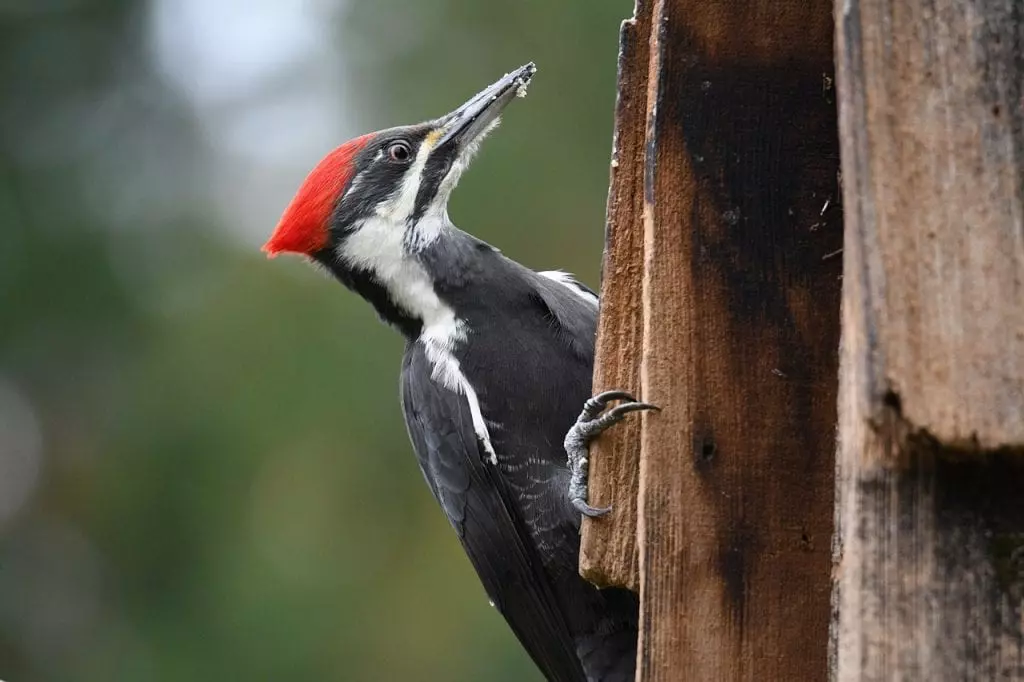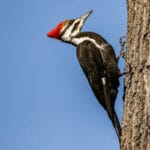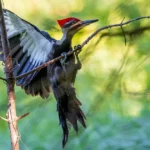Step into this woodpecker wonderland where these feathered percussionists take center stage! With lightning-fast pecking and shock-absorbing skulls, these remarkable birds have adapted to their own unique corner of the world. Curious about their secrets? Dive in and let’s explore their fascinating traits, surprising skills, and the special roles they play in our ecosystems.
Fun Facts About Woodpeckers
Woodpeckers are more than just those birds you hear drumming on trees – they’re actually pretty amazing creatures! Let’s delve into some fascinating facts about these feathered wonders:
1. Tongue-Twister Alert! Ever wonder how woodpeckers snag those tasty insects hiding deep inside trees? Their secret weapon is their tongue – it can be twice as long as their beak! Imagine being able to stick your tongue out twice the length of your nose! This super-long tongue acts like a sticky trap, allowing them to extract insects and keep forests healthy by controlling insect populations.
2. Built-in Helmets? You’ve gotta wonder how woodpeckers hammer their heads against trees all day and don’t end up with constant headaches. Well, they’ve got some seriously impressive adaptations! Their skulls and neck muscles are specially designed to absorb the shock of all that pecking. It’s like they have built-in helmets! Researchers are still trying to fully understand how their brains handle the impact, making woodpeckers a fascinating subject for scientists studying impact resistance.
3. More Than Just a Pretty Beak: Woodpeckers are social butterflies, or should we say, social peckers? The Acorn Woodpecker, for example, is known for its remarkable cooperative breeding behavior. They live in family groups where several birds help raise the young. Plus, they love to play games with each other! Who knew these feathered friends had such complex social lives?
4. Home Sweet… Tree Hole? Unlike birds that build nests in branches, woodpeckers create their own cozy homes by excavating cavities in trees. Talk about ambitious home renovations! These cavities aren’t just for them, though. They become valuable real estate for other creatures seeking shelter, like squirrels, bats, and even other bird species. Talk about being a good neighbor!
5. Exceptional Climbers: Have you ever seen a woodpecker effortlessly cling to the side of a tree? It’s all thanks to their amazing feet! They have what’s called “zygodactyl” feet – two toes point forward and two point backward. This unique arrangement gives them incredible grip and stability, allowing them to climb and cling to trees with ease. It’s like they have built-in climbing gear!
So, there you have it – some fun and fascinating insights into the world of woodpeckers. They’re not just noisy neighbors; they’re incredible examples of adaptation, social complexity, and ecological importance. Next time you hear that familiar drumming sound, take a moment to appreciate the fascinating lives of these feathered architects of the forest!
What Makes Woodpeckers Special?
We’ve already talked about some of the cool things about woodpeckers, but let’s dive a little deeper into what makes these birds so incredible.
Their constant pecking is probably one of the first things that comes to mind when you picture a woodpecker. It’s wild to think they can do that all day without getting headaches! As it turns out, they have incredibly tough skulls that act like shock absorbers, protecting their brains from all those impacts.
And speaking of amazing adaptations, have you ever seen a woodpecker’s tongue? They’re super long, often twice as long as their beak, and they use them like tiny spears to snag insects hiding deep inside trees. Talk about a built-in tool!
And if you thought that was cool, wait until you hear about their feet! Instead of having three toes facing forward and one back like most birds, woodpeckers have two toes facing forward and two backward. This special arrangement, called “zygodactyl feet,” gives them an incredibly strong grip, letting them cling to tree trunks and branches with ease.
But woodpeckers aren’t just cool to look at, they play a really important role in keeping our forests healthy. Think of them like tiny pest control experts! By gobbling up all those insects, they help keep populations in check, which benefits the entire ecosystem. And as if that wasn’t enough, their abandoned nesting cavities become cozy homes for other birds and even some small mammals, kind of like natural apartment complexes! This is super important for promoting biodiversity, meaning a wider variety of plants and animals can thrive in the same area.
Now, while we might think of pecking as just a way to find food, woodpeckers actually use it to communicate too! It’s like their own special language, with different drumming patterns used for attracting mates, defending territory, and even just saying “hello.” Some woodpeckers, like the Acorn Woodpecker, are even known to work together in family groups, sharing food and helping each other raise their young. That’s some serious teamwork!
And if you thought all woodpeckers were the same, think again! There are over 200 different species scattered all over the world, each with its own unique look, habitat, and diet. From the desert-dwelling Gila Woodpecker to the high-altitude Three-toed Woodpecker, these birds have adapted to thrive in some pretty incredible environments. And just like their beaks and tongues are perfectly suited for snagging insects, some woodpecker species have evolved specific adaptations for their chosen food source.
For example, did you know that yaks have double coats to keep them warm in extreme climates? It’s these kinds of adaptations that make the animal kingdom so fascinating! fun facts about yaks
While we’ve learned a lot about woodpeckers, there’s still so much more to discover. Scientists are constantly making new observations and conducting research to better understand their behavior, communication, and the complex relationships they have with their environment. Each new study brings us one step closer to unraveling the mysteries of these fascinating creatures and appreciating the crucial role they play in the natural world.
What Are Some Facts About Woodpeckers for Kids?
Woodpeckers are pretty incredible, right? They’ve got all these cool tools that help them thrive in the forest! One of the first things you probably notice about a woodpecker is its beak. It’s like a tiny jackhammer made of super-tough stuff called keratin—the same stuff in your fingernails! This lets them hammer away at wood looking for yummy insects or excavating cozy nests.
But their beak is only half the story. Have you ever seen a woodpecker’s tongue? It’s crazy long and sticky, almost like built-in flypaper! They can whip that tongue deep into holes and cracks to snag insects hiding inside.
Now, imagine pecking on wood all day long. Wouldn’t your head start to hurt? Woodpeckers don’t have that problem! They’ve got these special muscles in their heads that act like shock absorbers, protecting their brains from all that pounding.
And guess what? Woodpeckers aren’t loners. They’re pretty social birds, actually! They live together in groups called clans, which can be as small as a family or as big as a whole neighborhood of woodpeckers! They chat with each other using all sorts of interesting calls and by drumming on trees, kind of like their own special language.
These amazing birds are more important than you might think. They’re like tiny forest guardians! By gobbling up pesky insects that could harm trees, they help keep the forest healthy. Plus, those cozy nesting cavities they carve out? Other animals, like owls and squirrels, often move in once the woodpeckers are done with them. So, the next time you see a woodpecker, give a little cheer for these hard-working, tree-loving birds!
What is a Fun Fact About a Red-Headed Woodpecker?
Red-headed Woodpeckers are already pretty cool with their bright red heads, but they have some hidden talents too! You know how most woodpeckers peck at trees to find bugs? Well, these guys are like the ninjas of the bird world because they can actually snag bugs right out of the air! They’ll just chill on a branch, keeping a lookout, and then BAM! They zoom out, snatch the bug with their tongue, and it’s dinner time.
And get this – they’re super organized eaters. They find a cozy little hole in a tree and stuff it with live insects, like grasshoppers. Yep, they keep them alive in there for a snack later. But here’s the really wild part: they’re the only woodpeckers who cover up their stash with bark! Scientists think they do this to keep other animals from stealing their snacks. Pretty clever, right?
What Are the Unique Characteristics of a Woodpecker?
These busy birds aren’t just loud, they’re built to hammer! Unlike other birds, they have a whole bunch of cool adaptations that let them peck like crazy without getting headaches (or worse!).
One of the most amazing things? Their skulls. Imagine having a built-in shock absorber! That’s essentially what woodpeckers have. Their skulls are specially designed to spread out the force of each peck. This means the impact doesn’t go straight to their brain – phew!
And it’s not just their skulls; their neck muscles are super strong too. These muscles act like extra support, keeping their heads steady during all that intense hammering. It’s like having a really powerful neck brace!
But what about finding food? Well, woodpeckers have a secret weapon for that too: their tongues. These tongues are crazy long and flexible. They can snake into tiny cracks and crevices in trees to snatch up insects and sap. Talk about a built-in tool kit! These adaptations, along with their strong beaks and feet, make them incredibly effective at finding food in places most birds wouldn’t even think to look.
Now, you might be thinking, “Why all the pecking in the first place?” Well, woodpeckers aren’t just making noise for fun (though it might seem like it sometimes). They peck for a few important reasons.
First, it’s how they find food. Those tasty insects and grubs hiding under bark? Pecking is the way to get to them.
Second, woodpeckers need homes too. Their pecking helps them excavate cozy cavities in trees for nesting. These cavities often get reused by other birds and animals in the forest, making the woodpecker a true champion of the ecosystem.
Finally, they use those pecking skills for communication. You know how some birds sing beautiful songs? Woodpeckers have their own kind of “drumming” language. They peck on trees to mark their territory and attract mates.
While we know a lot about woodpeckers, research is ongoing, and we might be surprised by what we learn in the future. One thing is certain – these birds are a unique and fascinating part of our natural world.
What Special Ability Does a Woodpecker Have?
We’ve talked about how cool woodpeckers are, but let’s dive deeper into what makes them such incredible creatures. These birds aren’t just hammering on trees for fun (though it might seem like it!). They have some serious skills and physical adaptations that allow them to thrive in their world of wood.
Built for Pecking: It’s All in the Head (and Tail!)
Imagine pecking on a tree all day. You’d probably get a headache pretty quickly! But woodpeckers are built differently. Their head muscles are super strong, like a tiny but mighty construction crew, and their beaks are specially shaped, like a chisel you’d use for woodworking. This combo lets them drill those perfectly round holes you see in trees. And it’s not just about brute force; they’re incredibly precise too.
But hold on, there’s more! Have you ever tried standing on a tree trunk? It’s slippery and unstable. Woodpeckers have super strong tail feathers that act like a third leg, giving them amazing balance. Plus, their toes are arranged in a unique way – two facing forward and two facing backward – to help them cling on tight.
Hear a Grub, Eat a Grub: Super Senses and a Tongue with Tricks
Ever wonder how woodpeckers find insects hiding deep inside trees? Their hearing is phenomenal, like having built-in bug detectors. They can hear even the tiniest sounds of grubs munching on wood.
But hearing the grub is only half the battle; they need to get to it! And that’s where their tongue comes in. This isn’t your average bird tongue; it’s super long, sometimes even longer than their entire body! And it’s not just long; it’s sticky, barbed, and can snake into all those nooks and crannies to extract tasty treats. Some woodpeckers can even extend their tongue sideways, reaching places other birds can only dream of.
More Than Meets the Eye: Social Lives and Brainy Adaptations
Woodpeckers aren’t just solitary creatures focused on their next meal. Some types, like the Acorn Woodpecker, are all about family. They live in big groups, sharing the tasks of raising their young and looking out for each other. And they’re surprisingly chatty! They use drumming patterns on trees, kind of like their own Morse code, to communicate with each other and mark their territory.
Now, let’s talk brains – literally! You’d think all that pecking would leave their heads scrambled, right? But nope, woodpeckers have evolved some incredible adaptations. Their skulls are extra thick and their brains are surrounded by special cushioning to absorb the shock, kind of like a natural helmet. They also have unique blood vessel arrangements in their heads that help prevent concussions.
The Mystery Continues: What We Still Don’t Know
We’ve learned a lot about woodpeckers, but there are still mysteries to unravel. Scientists are constantly studying their incredible adaptations, from their specialized tongues to their shock-absorbing skulls. For example, we’re still learning how their brains process information and navigate their complex social structures. So, the next time you see a woodpecker hard at work, remember that you’re witnessing a marvel of evolution, a creature with abilities we’re still working to fully understand.
Is a Woodpecker Intelligent?
So, we’ve talked about how woodpeckers are built like little feathered jackhammers, but what about their brains? Are they just instinct-driven machines, or is there something more going on upstairs?
Well, it’s not like woodpeckers are solving complex equations, but their behavior suggests a level of cleverness that goes beyond pure instinct. Take their pecking, for example. It’s not random; they choose specific spots on trees, often targeting areas where insects are likely hiding. This suggests they understand something about insect behavior and how to find their next meal.
And it’s not just about finding food. Woodpeckers are known for their drumming – those rapid-fire pecks they use for communication. They seem to understand that different drumming patterns convey different messages, like attracting a mate or defending their territory. That kind of communication requires some brainpower, right?
Then there’s their tool use. Some woodpecker species have figured out how to use twigs and pebbles to pry insects out of tight spots. It’s a simple tool, sure, but the fact that they can figure out how to use something in their environment to their advantage suggests a capacity for problem-solving.
Scientists are still trying to fully understand avian intelligence, and there’s debate about how to compare it to the intelligence of mammals like us. But when it comes to woodpeckers, it’s probably safe to say they’re more than just feathered robots. They might not be writing poetry anytime soon, but their adaptations, behaviors, and problem-solving skills suggest a bird with a surprising amount of smarts. Who knows what further research might uncover about the inner workings of their fascinating minds?
What Is the Significance of the Woodpecker?
We’ve already talked about some of the cool things about woodpeckers, but let’s dive a little deeper into why these birds are so important to the environment and what makes them so fascinating.
It’s easy to think of woodpeckers as just those birds that make a lot of noise pecking at trees, but they’re actually tiny superheroes for our forests! They’re like the pest control experts of the tree world, spending their days hunting down and gobbling up insects that could harm the trees. Think of them as little doctors, pecking away at the bark to get to the bugs hiding underneath, kind of like removing a splinter!
But their impact goes beyond pest control. They’re like little construction workers too, creating homes not just for themselves, but for other creatures as well! Their strong beaks and chisel-like hammering help them carve out cozy cavities in trees, which might later be used by owls, squirrels, or other birds looking for a safe place to raise their families.
And have you ever wondered how they can hammer away at a tree all day without getting a headache? These birds are built for the job! They’ve got incredibly strong skulls that act like natural helmets, protecting their brains from all that intense pecking. Plus, their tongues are super long and sticky, perfect for reaching into those deep crevices and snagging their insect meals.
But woodpeckers aren’t just about work and eating; they’ve got a social side, too! Their drumming isn’t just random noise; it’s their way of communicating with each other. They use different drumming patterns to attract mates, defend their territory, or even locate a tasty grub hiding inside a tree. It’s like their own secret language!
And speaking of fascinating, there’s still so much we’re learning about these feathered wonders! Scientists are constantly making new discoveries about their behavior, their adaptations, and the crucial role they play in maintaining healthy forests. So, next time you hear the drumming of a woodpecker, take a moment to appreciate these amazing creatures and the important job they do!
What Are the Benefits of Woodpeckers?
So, we’ve talked about how cool woodpeckers are, but they’re not just interesting to watch! They actually do a lot for the environment. Think of them as little forest superheroes, working hard behind the scenes.
One of their main gigs is pest control. You see, woodpeckers love to eat insects – and we’re not just talking about a little snack. They have huge appetites for critters like bark beetles and carpenter ants, which can cause serious damage to trees if their populations get out of control. By keeping these pests in check, woodpeckers are like natural guardians of the forest, reducing the need for chemical pesticides that could harm other plants and animals.
But that’s not all! Remember those holes they drill in trees? Well, those holes aren’t just for finding food. They actually create cozy little apartments that other animals can use! Owls, squirrels, bats, even some ducks – they all might move into a vacant woodpecker cavity. It’s like woodpeckers are running a wildlife hotel, boosting the diversity of critters that can live in an area.
And speaking of helping plants, woodpeckers are surprisingly good gardeners. They eat fruits and berries, and the seeds from those fruits pass through their digestive system and get deposited – you guessed it – in their poop! This might not sound glamorous, but it’s a really effective way to spread seeds far and wide, helping new trees and plants to grow.
Think of it this way: when woodpeckers hammer away at a dead tree, they’re not just making noise. They’re actually removing diseased or insect-infested wood, which helps to keep the whole tree healthy. It’s like they’re performing surgery, but with beaks instead of scalpels!
And let’s not forget the soundtrack they provide! The drumming and calling of woodpeckers adds a certain charm to a walk in the woods.
Of course, there’s still a lot we’re learning about woodpeckers and their complex role in the ecosystem. Some scientists believe they might even influence the types of trees that grow in a particular area, just by choosing where they forage and nest. It’s an area of ongoing research, and it’ll be fascinating to see what new discoveries are made in the years to come.
So, the next time you see a woodpecker, take a moment to appreciate these amazing creatures. They might seem like simple birds with a knack for pecking, but they’re actually vital contributors to the health and diversity of our forests.
How Does a Woodpecker Peck So Fast?
We’ve all heard that unmistakable rat-a-tat-tat echoing through the trees, a sure sign that a woodpecker is hard at work. But have you ever stopped to think about just how fast these feathered carpenters are? It’s truly impressive! They can hammer their beaks against wood up to 20 times per second – that’s faster than most of us can blink! So, how do they manage such a feat without turning their brains to mush? Let’s dig deeper.
One of the secrets lies in their specially designed heads. Imagine having a built-in helmet, and that’s basically what a woodpecker has! Their skulls are super thick and spongy, acting like a shock absorber to protect their brains from all that intense pounding. It’s like having a built-in safety feature, allowing them to peck with such force and speed without getting hurt.
But a strong head isn’t enough. They also need serious muscle power, and that’s where their neck muscles come in. These muscles are incredibly powerful, providing the necessary force to drive their beaks into wood with incredible speed. Think of it like a weightlifter using their muscles to lift heavy weights – it’s the same principle, just applied to pecking.
And let’s not forget about their tail feathers! They’re not just there for show. These stiff, pointed feathers act like a prop, bracing the woodpecker against the tree trunk and providing extra stability during those rapid-fire pecking sessions. It’s like having a third leg to keep them balanced and in position.
Then there’s the tongue – and what a tongue it is! Woodpeckers have these amazingly long, barbed tongues that extend far beyond their beaks. They use these tongues to probe deep into crevices and extract tasty insects hiding within the wood. It’s a perfect example of how nature provides specialized tools for specific jobs.
Now, let’s talk about the pecking itself. Woodpeckers have special beak muscles that allow for lightning-fast movements. These muscles work in perfect sync, enabling them to strike the wood with incredible precision and speed. And to maintain their balance while pecking, they use their uniquely designed feet, which have two toes facing forward and two facing backward – a fancy term called “zygodactyl feet.” This arrangement provides a super strong grip on the tree trunk, preventing them from losing their footing during those intense pecking sessions.
But all this pecking requires a lot of energy, right? You bet! That’s where things get even more interesting. Scientists believe that woodpeckers have unique biochemical processes happening in their pecking muscles. These processes likely reduce the amount of energy needed for each peck, allowing them to keep up their rapid-fire drumming without getting tired too quickly. It’s like having a super-efficient engine that optimizes fuel consumption.
So, there you have it! The next time you hear a woodpecker hammering away at a tree, take a moment to appreciate the incredible adaptations that allow them to perform this feat. From their shock-absorbing skulls to their powerful neck muscles and specialized feet, these birds are a true testament to the wonders of nature’s engineering.
Of course, there’s still much we don’t know about woodpeckers and their incredible pecking abilities. Scientists are constantly making new discoveries and refining our understanding of these fascinating creatures. But one thing’s for sure: the more we learn about woodpeckers, the more amazing they seem!
How Do Woodpeckers Help Humans?
We’ve already talked about how awesome woodpeckers are, but did you know they actually lend us humans a helping hand (or wing, maybe?) in quite a few ways? Let’s dig a bit deeper into how these feathered friends make our lives better just by doing their thing.
One of the biggest ways woodpeckers help us out is by being incredible pest control. These birds can really pack away the insects! Think about it: all those creepy crawlies munching on our trees and crops, causing damage and spreading diseases. Woodpeckers swoop in like tiny, feathered superheroes and gobble up huge amounts of these pests. This means we might not need to use as many pesticides, which can be harmful to the environment and even to us.
And it’s not just about eating the bugs we can see. Woodpeckers often find insects hiding under the bark that other birds miss. They’re like expert tree doctors, listening for signs of infestation and then pecking away to get to those hidden invaders.
But wait, there’s more! Woodpeckers don’t just eat bugs; they’re also expert home builders, which benefits other forest dwellers. Those holes they drill in trees? Those become cozy apartments for all sorts of creatures. Owls, squirrels, bats, even some ducks – they all might move into a vacant woodpecker dwelling. It’s like woodpeckers are running a wildlife hotel chain! This diversity of animal life is super important for keeping our forests healthy and thriving.
And speaking of keeping forests healthy, did you know that woodpeckers play a role in planting trees? Well, sort of! They love to munch on fruits and nuts, and when they do, they often carry the seeds away from the parent tree. Sometimes they drop these seeds, and guess what? Those seeds can sprout into brand new trees! This helps forests to spread out and grow, ensuring there are plenty of trees for the future.
Now, let’s talk about tree health. It might seem counterintuitive, but those holes woodpeckers peck can actually be beneficial in the long run. They tend to go after trees that are already weakened or diseased, picking out the infected parts. This can actually help to stop the disease from spreading further and might even save the tree’s life!
Here’s the thing about science – we’re always learning more! While we have a pretty good understanding of how woodpeckers help us, there are probably even more ways we haven’t even discovered yet. That’s what makes studying nature so exciting – there’s always something new to find out!
- Sept 31 Myth: Unveiling Calendar Secrets - March 18, 2025
- How Long & Till December 18, 2025: Accurate Countdown Guide - March 18, 2025
- Discover Japanese Artists: A Complete History - March 18, 2025
















